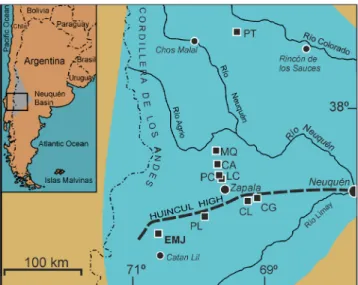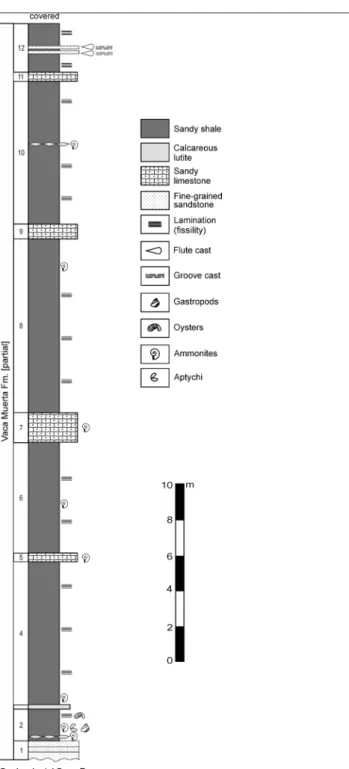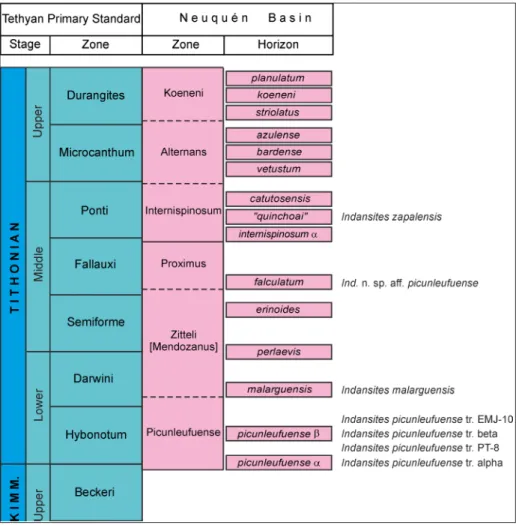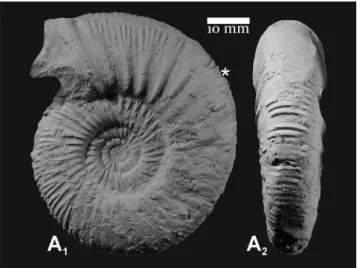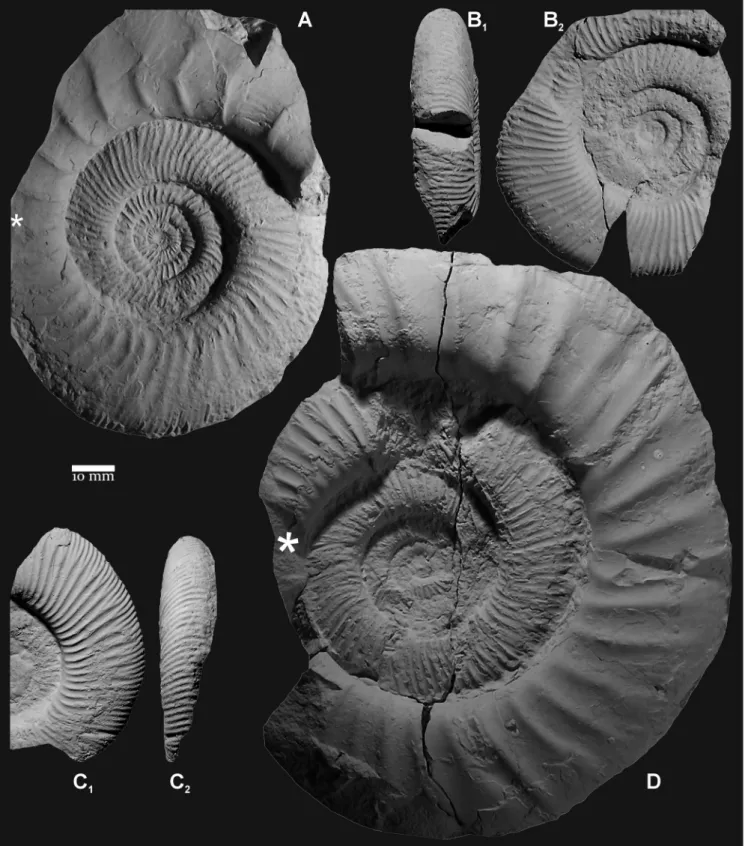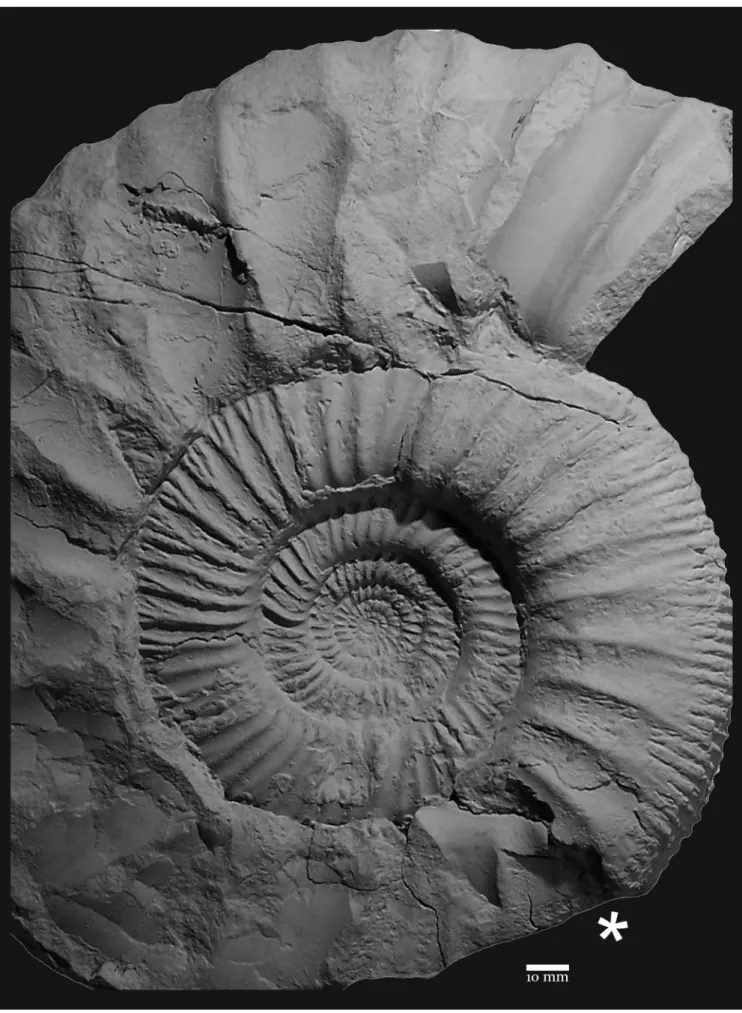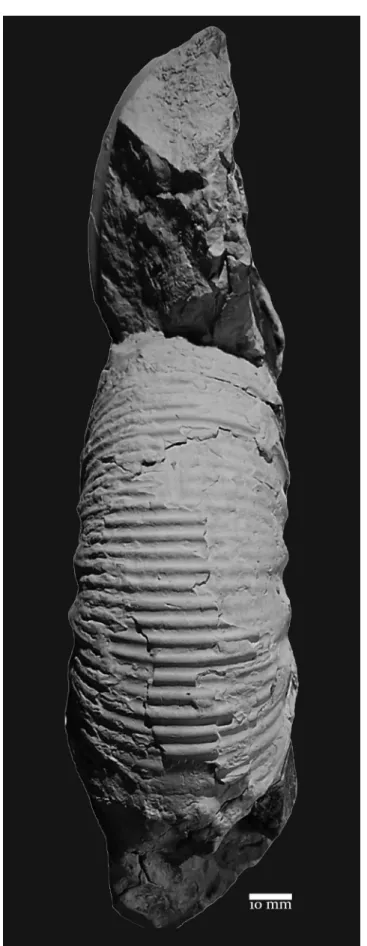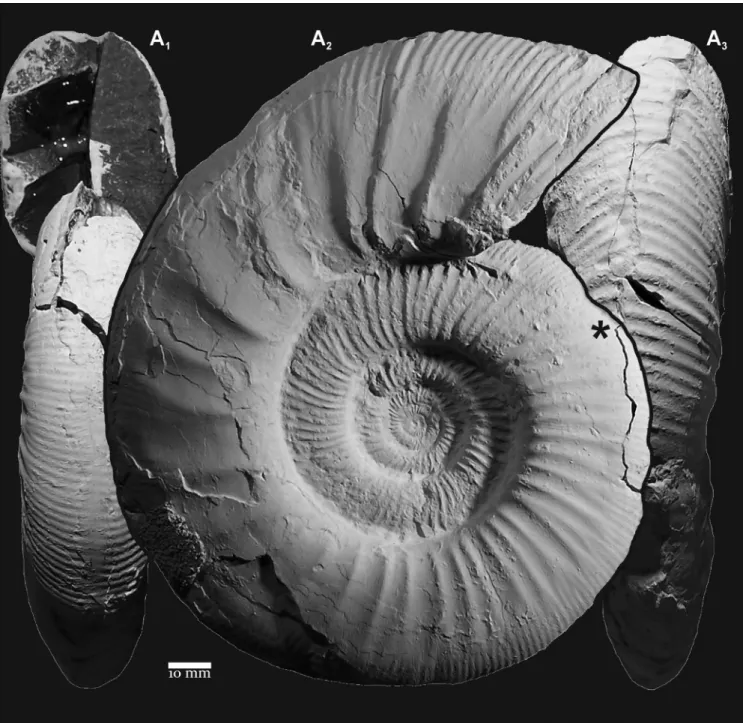AMMONITES OF THE SUBFAMILY ZAPALIINAE FROM THE LOWER TITHONIAN OF ESTANCIA MARÍA JUANA, VACA MUERTA FORMATION (PORTADA COVUNCO MEMBER), NEUQUÉN BASIN, ARGENTINA
HORACIO PARENT1*, ALBERTO C. GARRIDO2, ARMIN SCHERZINGER3, GÜNTER SCHWEIGERT4 & LUCIANO BRAMBILLA5
1* (Corresponding author) Laboratorio de Paleontología, IFG, Facultad de Ciencias Exactas, Ingeniería y Agrimensura, Universidad Nacional de
Rosario, Pellegrini 250, 2000 Rosario, Argentina. E-mail: [email protected]
2Museo Provincial de Ciencias Naturales “Prof. Dr. Juan A. Olsacher”, Dirección Provincial de Minería, Etcheluz y Ejército Argentino, 8340
Zapala, Neuquén, Argentina & Departamento Geología y Petróleo, Facultad de Ingeniería, Universidad Nacional del Comahue, Buenos Aires 1400, 8300 Neuquén, Argentina. E-mail: [email protected]
3Maurenstraße 26, 78194 Immendingen-Hattingen, Germany. E-mail: [email protected]
4Günter Schweigert: Staatliches Museum für Naturkunde, Rosenstein 1, 70191 Stuttgart, Germany. E-mail: [email protected] 5Facultad de Ciencias Bioquímicas y Farmacéuticas, Universidad Nacional de Rosario, Suipacha 531, 2000 Rosario, Argentina. E-mail:
To cite this article: Parent H., Garrido A.C., Scherzinger A., Schweigert G. & Brambilla L. (2019) - Ammonites of the subfamily Zapaliinae from the Lower Tithonian of Estancia María Juana, Vaca Muerta Formation (Portada Covunco Member), Neuquén Basin, Argentina. Riv. It. Paleontol. Strat., 125(2): 433-448.
Abstract. A new collection of ammonites from the Picunleufuense Zone (standard base of the Andean
Ti-thonian) of the locality Estancia María Juana (southern Neuquén Basin, Argentina) has provided abundant and well preserved material of new transients of Indansites picunleufuense and Choicensisphinctes platyconus. These transients are
described and a detailed review of the early evolution of the Indansites lineage is presented. The meaning of changes
in rib density, variations within the microconchs (males) and the length of the bodychamber in Indansites picunleufuense
are discussed. It is concluded that the changes in rib density which characterize the successive macroconchs of the transients indicate changes in the rate of shell-growth. The more densely ribbed phragmocone of later transients would have had lower growth rates, which would also explain their smaller adult size. The microconchs show high variation in adult size suggesting high plasticity in the size-age maturation, most likely caused by influence of seasonal environmental conditions. A large small-macroconch-like lapetted microconch, coming from the close locality Picún Leufú, is interpreted as a new case of sex-change.
Received: January 22, 2019; accepted: April 24, 2019
Keywords: Picunleufuense Zone; lower Tithonian; Vaca Muerta Formation; Ammonoidea; Indansites; Choicensisphinctes.
I
ntroductIonIn the last years, it has become evident that, during the Tithonian the only ataxioceratids in the Neuquén Basin (NB; Fig. 1) are represented by the subfamilies Torquatisphinctinae Tavera, 1985, Za-paliinae Parent, Schweigert, Scherzinger, and Garri-do, 2017, and Ataxioceratinae Buckman, 1921 (ge-nus Paraboliceras Uhlig, 1910) (Parent 2003; Parent et al. 2006, 2011a, 2011b, 2013a, 2015, 2017a, 2017b; Garrido et al. 2018). Nevertheless, some genera (e.g. Aulacosphinctes, Virgatosphinctes, Pseudinvoluticeras) of
the Himalayitidae Spath, 1925 and Virgatosphinc-tinae Spath, 1923, a subfamily restricted to the Indo-Madagascan region (Enay 2009; Parent et al. 2017a), are still mentioned to include Andean am-monites (e.g. Zeiss & Leanza 2010; Vennari 2016; Iglesia-Llanos et al. 2017). However, the latter are typical representatives of the Zapaliinae. The crite-ria adopted for these assignations have never been explained, perhaps because they were proposed by Uhlig (1910), Spath (1925), and Weaver (1931), among other old papers. Under these circumstances it is strongly suggested caution in the classification of new specimens and in their use for chronostrati-graphic purposes.
The lower Tithonian ammonite fauna of the southern domains of the Neuquén Basin (Fig. 1) seems to show few differences with respect to those of its central and northern regions (see Leanza 1980; Parent et al. 2011a, 2011b, 2013b, 2015; Garrido et al. 2018 and references therein). The genus Indansites Vennari, 2016 is one of the main components of the subfamily Zapaliinae, with an abundant record throughout virtually all of the basin, from the lower Tithonian Picunleufuense Zone up to at least the middle Tithonian Internispinosum Zone.
The locality named Estancia María Juana (EMJ) belongs to the region called Fortín Primero de Mayo, the geology of which has been described by Leanza et al. (2003). The Tithonian stratigraphic sequence of this locality and the ammonite fauna of the Portada Covunco Mb. were studied by Parent et al. (2013b). We have restudied this section, expand-ing the number of ammonite horizons sampled, especially after disclosing the upper part of the se-quence, formerly covered. In this section, there are interesting records of Indansites and Choicensisphinctes Leanza, 1980 in the Picunleufuense standard Zone, in levels which seem to have not been previously recorded in other localities.
The purpose of this paper is to describe these recently collected ammonites and to review the evo-lution of the early transients of Indansites in the Pi-cunleufuense standard Zone, which is the base of the Andean Tithonian.
S
tratIgraphIcframeworkThe Picún Leufú Subbasin (PLSB) in the southern Neuquén Basin (Fig. 1) shows specific ge-ological, stratigraphical and palaeontological featu-res which have been studied by several authors (e.g. Groeber 1929; Leanza & Leanza 1979; Leanza 1992; Leanza & Hugo 1997; Leanza et al. 2003 with refe-rences therein, Spalletti et al 2000; Garrido & Parent 2013; Parent et al. 2011a, 2013b). The marine Ti-thonian is mainly represented by the Vaca Muerta, Carrín Curá, and Picún Leufú formations. The two latter units pass gradationally from the bituminous sandy shales and calcareous sandstones of the Vaca Muerta Fm into near-shore sandstones and carbo-nate, tidally dominated, rimmed-shelf facies (Lean-za & Hugo 1997; Lean(Lean-za et al. 2003; Armella et al. 2007). The lower Tithonian, typically represented in the PLSB by the Portada Covunco Mb. of the Vaca Muerta Fm. (Parent et al. 2013a), is well characterized by an ammonite association widely recorded throu-gh the entire basin, lying below the Zitteli [including the “Mendozanus”] Zone (Parent et al. 2011a).
As noted above, the studied section of EMJ was already described in Parent et al. (2013b). The log-section shown in Fig. 2 is more detailed after di-sclosing of the previously covered upper part. Equi-valences between former levels (Parent et al. 2013b: fig. 2) and the notation used herein (Fig. 2) are: levels EMJ-1-2 merged into EMJ-2; EMJ-3 unchanged; 4-5 (plus covered portion) splitted into EMJ-4-10; and EMJ-6 splitted into EMJ-10-12. The rock and ammonite succession, and accessory molluscs recorded is as follows, from below, with the new le-vels' notation:
Level EMJ-1: 1.5 m of fine-grained sandsto-nes. No macrofossils.
Level EMJ-2: 2 m of sandy shales. Ammo-nites: Indansites picunleufuense [M&m] transient alpha, abundant Choicensisphinctes platyconus [M&m] (see Pa-rent et al. 2013b); abundant oysters. Gastropods: Exelissa? arcuatoconcava Gründel & Parent, 2001, Di-croloma? sp.
Level EMJ-3: 0.2 m bank of sandstones. No macrofossils.
Level EMJ-4: 8 m of sandy shales. Ammo-nites (from the lower 2 m): abundant fragmentary I. picunleufuense [M&m] transient alpha, C. platyconus [M&m]. Oysters.
Fig.1 - Southern Neuquén Basin (modified from Garrido et al. 2018) with indication of the localities studied and referred in text: Estancia María Juana (EMJ), Picún Leufú (PL), Cerro Lo-tena (CL), Cerro Granito (CG), Los Catutos (LC), Portada Covunco (PC), Cañadón de los Alazanes (CA), Mallín Que-mado (MQ), Pampa Tril (PT).
Level EMJ-5: 1 m thick bank of sandy lime-stones. Ammonites: crushed specimens of Choicen-sisphinctes sp.
Level EMJ-6: 6 m of sandy shales. Ammoni-tes: Indansites picunleufuense, Choicensisphinctes sp.
Level EMJ-7: 1.8 m of sandy limestones. Am-monites: abundant I. picunleufuense (transient beta?), C. platyconus.
Level EMJ-8: 9.8 m of sandy shales.
Ammo-nites (upper part): I. picunleufuense and C. platyconus. Level EMJ-9: 1.0 m of sandy limestones. No macrofossils.
Level EMJ-10: 8 m of sandy shales. Ammo-nites: I. picunleufuense (transient EMJ-10, see below), C. platyconus.
Level EMJ-11: 0.4-0.5 m bank of sandy lime-stones. No macrofossils.
Level EMJ-12: more than 3 m (covered) of sandy limestones and shales. No fossils.
The levels EMJ-1-10 belong to the Picunleu-fuense Zone. The lower part (levels EMJ-1-4) can be assigned to the picunleufuense alpha Hz. (Fig. 3). Levels EMJ-6?-7 could be assigned to the picunleu-fuense beta Hz. (see discussion below). Levels EMJ-8-10 are younger than the picunleufuense beta Hz. (see discussion below). Levels EMJ-11-12 cannot be da-ted as they lack fossils.
S
yStematIcp
alaeontologyConventions. The material described is housed at the
Mu-seo Provincial de Ciencias Naturales “Prof. Dr. Juan A. Olsacher”, Zapala (MOZ-PI). Bodychamber is abbreviated with Bc and phrag-mocone with Ph; macroconch (female): [M], microconch (male): [m]. Measurements are indicated as follows: diameter (D), diameter at the
last adult septum (Dls) and diameter at adult peristome (Dp), all given
in millimeters [mm]; umbilical width (U), whorl width (W), whorl
height (H1), and whorl ventral (or apertural) height (H2), all given
as dimensionless proportions of D; length of bodychamber (LBC)
in degrees [°]. Number of primary (P) and ventral (V) ribs per half
whorl. Levels of occurrence of the specimens denoted by the level number in Fig. 2 and the prefix EMJ (Estancia María Juana). Zones and biohorizons referred to Fig. 3.
Composition of the fauna. The only
am-monite genera recorded in the studied section are Indansites Vennari, 2016 and Choicensisphinctes Leanza, 1980. Their relative abundance changes through the section:
(1) In level EMJ-2 Choicensisphinctes dominates (95%) over Indansites (5%). Choicensisphinctes occurs mainly as macroconchs (70%); there are only six mi-croconchs (30%) from a total of 20 specimens. The few specimens of Indansites are fragmentary, appa-rently macroconchs.
(2) In level EMJ-10 the proportions revert, Choicensisphinctes occurs as a minority (9%) with re-spect to Indansites (91%). All the specimens of both genera collected in this level are macroconchs.
Fig. 2 - Log of the studied section of the lower part of the Vaca Muerta Fm., Portada Covunco Mb. in Estancia María Juana. Total thickness 41.8 m. Levels EMJ-1-10 belong to the low-ermost Tithonian Picunleufuense Zone (see Fig. 3).
The Picunleufuense Zone (lower Tithonian) ammonite fauna of the studied locality is composed exclusively of Andean genera (Indansites and Choi-censisphinctes). Nevertheless, in other close localities of the PLSB, e.g. Picún Leufú, Cerro Lotena-Cerro Granito and Carrín Curá (Fig. 1), the fauna is richer including the remaining genera widely recorded in central and northern areas of the NB, mainly Catu-tosphinctes, Cieneguiticeras, and Physodoceras (see Leanza 1980; Parent et al. 2011a, 2013a). Only the latter is cosmopolitan, whereas the other two are endemic to the Andean Realm.
The settlement of the first ammonites ente-ring the Neuquén Basin duente-ring the early flooding (Picunleufuense Zone) must be studied from the faunas of the picunleufuense alfa and beta biohorizons (Fig. 3) which are the earliest records of the Andean Tithonian. These horizons are represented throu-ghout virtually all the basin, in the base of the Vaca Muerta Fm. (e.g. Fig. 2). However, a detailed analysis of the early Tithonian geography and physiography and the local faunas of many key localities of the basin must be considered together for this kind of study. This study is in progress under the hypothesis
that the early settlements of ammonites in the NB consisted of non-indigenous species with similar ecological requirements, i.e. a biome (sensu Dom-mergues & Marchand 1988). These species, coming from different areas (Tethys, Antarctica?, Indo-Ma-dagascan region), should have been established in the Palaeopacific basins, which were separated from the NB by the volcanic arc emplaced with Andean orientation (Fig. 1). The evolution of some of these species, early established in the NB, would have lead to the development of local lineages, giving origin to an Andean biota (a fauna dominated by eudemic lineages, sensu Callomon 1985). For progressing in this study, several features of the NB must be con-sidered that should have affected the distribution of the fauna and, importantly, the migrations. The most important of these features seem to be: (1) the tendency to the isolation of the basin due to the tectonic-eustatic dynamics affecting the transarc ga-teways, (2) the large area covered by the basin divi-ded into two main domains (the elongated Mendo-za Shelf and the Neuquén Embayment) which must have imposed different environmental conditions, and (3) the irregular bottom topography.
Fig. 3 - Reference Andean chro-nostratigraphic ammonite zonation and biohorizons (based on Leanza 1981 and Parent et al. 2015), correlat-ed with the Tethyan Primary Standard Scale (Geyssant in Cariou & Hantzpergue 1997). Dotted lines indi-cate non-standard zones. Succession of representa-tives of the genus Indansites
as discussed in Parent et al. (2011a, 2015, 2017a) and present report.
Order Ammonitida Fischer, 1882
Suborder Ammonitina Fischer, 1882
Superfamily Perisphinctoidea Steinmann, 1890 Family Ataxioceratidae Buckman, 1921 Subfamily Zapaliinae Parent, Schweigert,
Scherzinger and Garrido, 2017 Genus Indansites Vennari, 2016 Type species: Subplanites malarguensis Spath, 1931; by original
designation.
Remarks. Indansites consists of a lineage,
which ranges from the basal Andean Tithonian Pi-cunleufuense Zone up to at least the upper Middle Tithonian Internispinosum Zone (Fig. 3; see Parent et al. 2017a). Its representatives are characterized as compressed to more or less inflated serpenticones, strongly sexually dimorphic, with a well-defined macroconch sculpture-ontogeny: sharp bifurcat-ing ribs (inner whorls), narrowly splayed secondar-ies with the posterior one twisted backwards (sub-adult phragmocone), trifurcating in virgatotome s.str. style (adult phragmocone), and through the bodychamber progressively stronger trifurcate to fascipartite passing to stronger, irregular primaries towards the peristome.
Close resemblance, sometimes indistinguish-able, between earliest Indansites, namely I. picunleu-fuense and some representatives of Lithacoceras Hy-att, 1900 from the southern Tethys (see Parent et al. 2006, 2011a, 2011b, 2017a) is a clear indication of the origination of Indansites from Lithacoceras. Dif-ferentiation of Indansites as a separate lineage from that of Lithacoceras, however, is supported definitely by the different evolutionary trends developed in separated basins. The evolutionary trend of Indan-sites was summarized and illustrated by Parent et al. (2017a). The detailed record of the succession of transients of I. picunleufuense in the Picunleufuense (standard) Zone is analyzed in detail below, based on the newly collected material.
Indansites picunleufuense (Parent, Garrido,
Schweigert & Scherzinger, 2011)
Figs 4-10
1999 Lithacoceras (Virgalithacoceras) cf. acricostatum Ohmert & Zeiss
– Parent & Capello, p. 349
2001 Euvirgalithacoceras malarguense (Spath) – Gründel & Parent, p.
14, fig. 2
2003 Euvirgalithacoceras malarguense (Spath, 1931) – Parent, p. 147,
figs. 6A, 7C-E
2006 “Lithacoceras” n. sp. aff. malarguense (Spath, 1931) – Parent et
al., p. 257, figs. 2, 3A-B
2007 “Lithacoceras” n. sp. aff. malarguense (Spath, 1931) – Parent &
Cocca, p. 26
*2011a Lithacoceras picunleufuense n. sp. – Parent et al., p. 53, figs. 6-12
2011b Lithacoceras picunleufuense Parent et al., 2011 – Parent et al., p.
26, fig. 3
2013a Lithacoceras picunleufuense Parent et al., 2011 – Parent et al., p.
11, fig. 5A
2013b Lithacoceras picunleufuense Parent et al., 2011 – Parent et al., p.
28
2015 Lithacoceras picunleufuense Parent et al., 2011 – Parent et al., p.
17, figs. 6-11
2016 Indansites malarguensis (Spath, 1931) – Vennari, pl. 1, figs. 1-3,
pl. 2, figs. 1-5, pl. 3, fig. 1
2017a Indansites picunleufuense (Parent et al., 2011) – Parent et al., p.
509, fig. 2A-C
2018 Indansites picunleufuense (Parent et al., 2011) – Garrido et al., p.
6, figs. 4-9, 10A-B.
2019 Indansites malarguensis (Spath, 1931) – Aguirre-Urreta et al., p.
354, fig. 8J-K
Material (new specimens from the studied section): one
complete adult [m] from level EMJ-2 (MOZ-PI-2293); 7 incomplete specimens from level EMJ-7 (MOZ-PI-1889/1-7); 10 more or less complete adult [M] and 10 juvenile or incomplete [M] phragmocones from level EMJ-10.
Description. (1) Microconch from level
EMJ-2 (Fig. 4): A finely preserved adult micro-conch, moderately involute (U/D = 0.35 from D = 46 mm up to the peristome) with higher than wide whorl section (W/D = 0.28 from D = 46 mm up to the peristome). Primary ribs bi- and trifurcating in the phragmocone and polyfurcating in the body-chamber. The bodychamber begins at Dls = 51 mm and is unusually short, only 70° long. Maximum dia-meter at peristome Dp = 59 mm. Lappets short.
(2) Macroconchs from level EMJ-7: Phrag-mocones (D = 60-80 mm) showing compressed and evolute whorls. Densely ribbed from inner whorls: P = 21-26 through D = 33-80 mm.
(3) Macroconchs from level EMJ-10 (Figs 5-7): Moderately large, compressed and evolute serpenticonic conchs. The ontogeny can be conve-niently described as four stages:
- Inner whorls (Fig. 5A), about D < 20-30 mm, evolute, oval in whorl section. Primary ribs sharp and prosocline (P = 16-23), bifurcating in up-per flank; one or two up-per whorl joined on the um-bilical shoulder.
- Middle whorls (Figs 5A1-A4, 6B-C), from about D = 30 mm, very evolute, with subrectangu-lar, higher than wide whorl section, venter rounded, and flattish flanks. At about 40 < D < 90 mm (su-badult phragmocone) the ribbing is very dense: P = 30-44, consisting of fine slightly flexuous ribs,
bi-furcating and occasionally tribi-furcating in the upper third of flank.
- End of the phragmocone and beginning of the bodychamber (Figs 6-7), Dls = 80-110 mm. Pri-mary ribbing becomes gradually less dense, display-ing a stage of trifurcates in virgatotome s.str. style.
- Adult bodychamber (Figs 6-7) evolute with oval to subrectangular, higher than wide whorl sec-tion, slightly uncoiled towards the peristome. Pri-mary ribs stronger and more widely spaced than in the phragmocone, bi- or trifurcating in the upper
third of the flank, with some intercalaries. Adult size at peristome shows moderately high variation, Dp = 120-220 mm; the length of the adult body-chamber ranges 270-340° long.
Remarks. The microconch from level
EMJ-2 (Fig. 4) of the picunleufuense alpha Hz. (Parent et al. 2013) is medium-sized and very similar to the microconchs from the same biohorizon from Picún Leufú (see Parent et al. 2011a: figs. 7C and 9E).
The specimens from level EMJ-7 (as well as poor material from level EMJ-6) consist mainly of densely ribbed adult phragmocones which are clo-sely comparable with macroconch phragmocones of the transient beta from Picún Leufú (Parent et al. 2011a: figs. 11-12). Although the material is not very well preserved, the rib density in the phrag-mocone, higher than in the transient alpha suggests that they most likely belong to the transient beta of the species.
The macroconchs from the level EMJ-10 are all widely umbilicate with compressed whorl section and densely finely ribbed phragmocone (Figs 5-8). Ribbing density shows a fall from D = 80-110 mm associated with the development of the short vir-gatotome s.str.-stage diagnostic of the species. The complete dominance of this morphotype in level EMJ-10, overlying the levels EMJ-6-7 which yield specimens comparable to the less densely ribbed variants of transient beta, strongly suggests this
Fig. 4 - Indansites picunleufuense transient alpha, complete adult
micro-conch (MOZ-PI-2293); Estancia María Juana, level EMJ-2,
picunleufuense alpha Hz., Picunleufuense Zone. Asterisk at last
septum.
Fig. 5 - Indansites picunleufuense (Parent et al., 2011) transient EMJ-10; Estancia María Juana, level EMJ-10, Picunleufuense Zone. Juvenile
macro-conch (MOZ-PI-2410/1) with incomplete bodychamber. A1-A3) ventral (overturned), lateral and apertural views (x1); A4) cross section of the phragmocone (x1) through the line indicated by arrow-heads in A2; A5-A6) inner whorls (x2). Asterisk indicating the last septum. Bar is 10 mm for A1-A4, 5 mm for A5-A6.
morphotype represents a transient younger than the transient beta. Unfortunately, no associated micro-conchs have been recorded yet – they would be very important for a more complete characterization of the species in the context of a strongly sexually
dimorphic lineage. Differences between transient EMJ-10 and the holotype of I. malarguensis are in the wider subtrapezoidal whorl section (Burckhardt 1903: pl. 4: 2) and the occurrence of several strong constrictions in the latter, although closely
resem-Fig. 6 - Indansites picunleufuense (Parent et al., 2011) transient EMJ-10; Estancia María Juana, level EMJ-10, Picunleufuense Zone. A) adult [M] with
part of bodychamber (MOZ-PI-2382). B) [M] phragmocone (MOZ-PI-2435). C) [M] phragmocone (MOZ-PI-2410/2). D) Complete adult [M] (MOZ-PI-2482). All x1. Asterisk at last septum.
bling each other in rib-density ontogeny (Fig. 8A). These differences and the older stratigraphic age of the transient EMJ-10 (Fig. 3) seem to be significant enough for excluding the possibility to include the latter in I. malarguensis.
The specimens of I. picunleufuense figured un-der I. malarguensis by Vennari (2016) have been
di-scussed in Parent et al. (2017a) and Garrido et al. (2018). The specimen figured in Aguirre-Urreta et al. (2019: fig. 8J-K) is a refiguration from Vennari (2016).
Transients of Indansites picunleufuense. The spe-cies was originally defined from two mean
morpho-Fig. 7 - Indansites picunleufuense (Parent et al., 2011) transient EMJ-10; Estancia María Juana, level EMJ-10, Picunleufuense Zone. Complete adult
Fig. 8 - Indansites picunleufuense (Parent et al., 2011), Picunleufuense Zone. Summary of morpho-ornamental and adult size changes
observed in the lineage represented by the four successive transients alpha, PT-8, beta, EMJ-10, illustrated by mean adult-macroconchs (plus microconchs of transient alpha) and data from published specimens from Casa Pincheira, Pampa Tril, Mallín Quemado, Picún Leufú, and E. María Juana. A) Ribbing ontogeny represented by the plot P versus D; adult size ranges
(maximum and minimum values of Dls and Dp); and ontogenetic sequence of rib-types of the species. The gray area indicates
the size-range within which the later transients beta and EMJ-10 differ by the higher rib-density from the older transients alpha and PT-8. The holotype of Indansites malarguensis (Spath) included for comparison. B) Transient alpha (type transient of the
species); B1: complete adult macroconch (MOZ-PI-11239) from the picunleufuense alpha Hz. in Pampa Tril (see specimen
natu-ral size in Figs 9-10); B2-B5: complete adult microconchs from Picún Leufú (modified from Parent et al. 2011a) showing the broad range of adult size; B6: specimen from level EMJ-2 in Fig. 4. C) Transient PT-8 (characterized by its larger size and lower density of ribbing through the ontogeny), complete adult macroconch from Pampa Tril (modified from Parent et al. 2015). D) Transient beta (characterized by high to medium rib-density in adult phragmocone and smaller adult size), complete adult macroconch from the picunleufuense beta Hz. in Pampa Tril (modified from Parent et al. 2015). E) transient EMJ-10
(character-ized by the higher rib-density in adult phragmocone and very compressed whorl section through juvenile ontogeny), complete adult macroconch shown in Fig. 7 from level EMJ-10. - All x0.25 including axes of graphs and rib types (A). The asterisk indicates the last adult septum. Some specimens turned left or right for homogeneous visualization. The number of specimens considered for each transient is indicated by n.
Fig. 9 - Indansites picunleufuense (Parent et al., 2011) transient alpha, Picunleufuense Zone, picunleufuense alpha Hz., Pampa Tril. Lateral view of a
types in close stratigraphic succession, interpreted as phyletic transients in the evolution of the lineage in the lower part of the Picunleufuense Zone (Fig. 3): transient alpha (the older and type transient) and transient beta (see Figs 8-10). Above as well as between the biohorizons of these two transients oc-cur other morphotypes, some of which show more or less distinctive variations (Figs 8B-E, 9-10). For example, in Pampa Tril a large and coarsely ribbed morphotype occurs between the biohorizons of the transients alpha and beta (Parent et al. 2015: figs. 5, 8C, 9-10). These specimens are herein labelled “transient PT-8” in reference to the level of occur-rence. The specimens from level EMJ-10 described above are provisionally labelled “transient EMJ-10” in reference to their level of occurrence in the stu-died section. These specimens show a higher rib density, a more compressed whorl section and come from a higher stratigraphic position than transient beta. Further local transients could be distinguished from the succession of different morphotypes in the sequence of the Picunleufuense Zone of Mallín Quemado (Garrido et al. 2018) where several levels with adult macroconchs have been sampled.
The main difference between the successive transients of the present species is essentially the rib-density in the size-range D = 40-110 mm, which corresponds to the subadult-adult macroconch phragmocone (Fig. 8A). In this size-range, the tran-sient alpha (as well as the local trantran-sient PT-8, which is additionally significantly larger) shows a variation within P = 18-24, whereas in the transients beta and EMJ-10 (present specimens) the rib-density varies within P = 18-44 (Fig. 8A). In the later transients, the ontogenetic stage of high density of the rib-bing is observable from the innermost whorls, at least from D = 5-8 mm (compare Fig. 5 herein and Parent et al. 2011a: fig. 10A with Parent et al. 2015: fig. 6A). It is worth noting that the ontogenetic se-quence of rib-types shown in Fig. 8A is characteri-stic of the species, observed in all the transients. On the other hand, the whorl section is wider and more rounded in the early transients, becoming more compressed, higher than wide in the late transients (Figs 5, 6B-C).
The specimens from Mallín Quemado level MQ-IV-7 assigned by Garrido et al. (2018: figs. 7-8) to the transient beta, seem to be better assigned to the slightly younger transient EMJ-10. On the other hand, the slightly older specimen of transient beta
Fig. 10 - Indansites picunleufuense (Parent et al., 2011) transient
al-pha, Picunleufuense Zone, picunleufuense alpha Hz., Pampa
Tril. Apertural view (x1) of a complete adult macroconch (MOZ-PI-11239); lateral view in Fig. 9.
from Mallín Quemado level MQ-IV-5 (Garrido et al. 2018: fig. 6) is very similar to those of transient EMJ-10. However, since it is associated with typical specimens of transient beta, it is a good example of the mode of phyletic evolution of the lineage based on changes in the spectra of patterns of variation.
Meaning of rib density. As described above, the differentiation of transients alpha, beta and EMJ-10 of I. picunleufuense is based on the rib-density in the phragmocone of the dominant adult macroconch morphotype in the sample. The described chang-es of rib-density do not correlate with significant changes in the relative umbilical diameter (U/D) as it would expected by the laws of covariation (Wester-mann 1966). In this sense, the rib-density is a valu-able taxonomic character so that it is important to discuss its interpretation in terms of the growth of the shell. The number of ribs per half whorl, P (Fig. 8A), is determined by the distance between each pair of consecutive ribs. This distance, representing the amount of shell formed, may vary indicating higher or lower growth rates. Assuming a rather constant amount of time required for the formation of the shell segment between each pair of ribs (Dommer-gues 1988; Landman et al. 2012), P becomes a mea-sure for the growth rate of the shell (cf. Webster & Palmer 2016). This means that the higher the rib density, the lower the rate of shell growth. In the case of I. picunleufuense, the juvenile phragmocone in the transients beta and EMJ-10 had thus lower growth rates than the transients alpha and PT-8.
Sexual dimorphism. The largest microconch known comes from Picún Leufú. It was formerly considered a small adult macroconch (Parent et al. 2011a: fig. 9D), but after additional preparation it ap-peared to be a large lappeted microconch (Fig. 8B2). The range of adult size in the microconchs of the earliest representatives of this species is thus very broad (Fig. 8B2-B5). This could be attributed either to different times of maturation, to different rates of growth, or both. However, considering that all specimens develop the same ontogenetic sequence of ribbing at fixed diameters we assume that the specimens have matured at different biological ages (cf. Bayer 1972; Matyja & Wierzbowski 2000; Parent et al. 2008; Schweigert & Kuschel 2017).
The smaller adults are paedomorphic by early halt of growth at maturation, i.e. progenesis
(Mc-Namara 1986; Parent 1997), as in most Ammoni-tina. Interestingly, broad ranges of variation in adult male size is an usual phenomenon in many Recent coleoids (e.g. Hanlon et al. 2002; Wada et al. 2005; Iwata et al. 2018), commonly induced by ecologial factors conditioning the time of maturation and re-production. Microconchs (males) of I. picunleufuense transient alpha can be collected in great abundance, associated with macroconchs (females) from a single bed (the picunleufuense alpha Hz.) in Picún Leufú (Par-ent et al. 2011a), indicating the specimens should be not affected by significant amounts of variation pro-duced by geographic distribution and/or phyletic evolution. Thus, the observed variation of adult size could be explained either by local fluctuations of en-vironmental/ecological conditions, e.g. maturation season, or by intraspecific genetic variation.
On the other hand, the above mentioned large lappeted microconch from Picún Leufú (Fig. 8B2) shows a strong ribbing on the last part of the bodychamber, matching that of the macroconchs at comparable diameters. This specimen may be inter-preted as a case of sex-change, in which a juvenile female transformed into a male in the premature stage. Similar cases have been described in Parent et al. (2008) for aspidoceratids and some perisphinc-tids.
Length of bodychamber. The very short bodychamber (LBC= 70°) of the microconchiate male (Fig. 4) from level EMJ-2 is unusual, within this species in particular, and among ataxioceratids in general. Microconch perisphinctoids (as well as hap-loceratoids) tend to have shorter bodychamber than the corresponding macroconchs, but rarely less than half a whorl. The present microconch from level EMJ-2 seems to have the shortest bodychamber yet found, even shorter than the specimen studied by Callomon & Chandler (1994: pl. 8: 4), a micro-conch? of Tmetoceras scissum (Benecke, 1865) from the Aalenian of England. The question raised by Callomon & Chandler (1994: 28) whether or not the shell was completely external, takes special relevance here with the present specimen. Unfortunately, the preservation of our specimen does not allow search-ing for evidences in the external surface of the shell that could give indication of attachment or intimate contact of an external part of the soft-body, like an external nacreous layer or other modifications (see details in Doguzhaeva & Mutvei 1989).
However, the unusually short bodychamber of our lappeted microconchiate male could be ex-plained by the model proposed by Klug et al. (2015: 265). According to this model, the pair of lappets could be interpreted as the terminal shell-segment for accommodating at least the cephalic portion of the animal. This “shell-segment” could have been secreted rapidly and economically (at low metabolic cost) considering the low amount of aragonite nec-essary compared to a complete “tubular” shell-seg-ment.
Genus Choicensisphintes Leanza, 1980 Type species: Perisphinctes choicensis Burckhardt, 1903; by original
designation.
Choicensisphinctes platyconus Parent, Garrido,
Schweigert & Scherzinger, 2011
Fig. 11
2001 Choicensisphinctes? sp. – Gründel & Parent, fig. 2
2003 Euvirgalithacoceras malarguense (Spath, 1931) – Parent, p. 147,
figs. 6B-C, 7A-B
2006 Choicensisphinctes cf. windhauseni (Weaver, 1931) – Parent et al.,
p. 254, fig. 5A-B
*2011a Choicensisphinctes platyconus n. sp. – Parent et al., p. 66, figs. 14-21
2011b Choicensisphinctes platyconus Parent et al., 2011 – Parent et al., p.
29, fig. 6A-B
2015 Choicensisphinctes platyconus Parent et al., 2011 – Parent et al., p.
19, figs. 12-16, 17B, non 28A
2016 Pseudinvoluticeras primordialis n. sp. – Vennari, p. 108, pl. 8, figs.
1-10
2017a Choicensisphinctes platyconus Parent et al., 2011 – Parent et al.,
fig. 3A-C
2018 Choicensisphinctes platyconus Parent et al., 2011 – Garrido et al.,
p. 9, figs. 10C, 11
2019 Pseudinvoluticeras primordialis Vennari, 2016 – Aguirre-Urreta et
al., fig. 8E
Material: One complete adult macroconch and one
fragmen-tary specimen from level EMJ-10.
Description. Evolute (U/D = 0.40) with
suboval, higher than wide whorl section (W/H1 = 0.75) through the ontogeny from D = 15 mm on-wards. Sculpture ontogeny shows three stages:
(1) inner whorls up to about D = 70 mm with fine primary ribs (increasing P = 13 to 34 through D = 5 to 70 mm), bifurcating in narrowly splayed secondaries;
(2) adult phragmocone and beginning of bodychamber (up to about D = 120 mm) with pro-socline primaries (P = 33 at D = 90 mm) dividing in the upper half to upper third of flank into three to five finer secondaries. These later become very weak and almost interrupted on the venter, thus forming
a wide ventral band;
(3) last half whorl of bodychamber with strong primaries, widely spaced and divided into th-ree to five weak secondaries; towards the peristome polyfurcation is irregular with several intercalaries. The bodychamber begins at Dls = 93 mm and is at least 240° long; the peristome seems to be preserved at the maximum D = 165 mm.
Remarks. The present specimens differ from
the holotype of the species, a macroconch of the earliest transient from the picunleufuense alpha Hz., by their more evolute coiling and finer ribbing, retai-ning a dense ventral ribbing throughout the body-chamber. The closest resemblance is with the evo-lute transient of this species from the picunleufuense beta Hz. in the present locality (Parent et al. 2013b: fig. 4), Picún Leufú (Parent et al. 2011a: fig. 21A) and Pampa Tril (Parent et al. 2015: figs. 17B).
It has been demonstrated (Garrido et al. 2018: 20) that Pseudinvoluticeras primordialis Vennari, 2016 is merely a junior synonym of C. platyconus. Indeed, the holotype of the former (Vennari 2016: pl. 8: 1) is exactly identical to the paratype-II of the latter (Parent et al 2011a: 66, fig. 15A) – both of them are microconchs with lappets.
c
oncluSIonThe Picunleufuense Standard Zone in the southern Neuquén Basin is consistently well-develo-ped forming the lower part of the Portada Covunco Mb. at the base of the Vaca Muerta Fm. This am-monite zone shows a dense record of fossiliferous levels, in which stands out the occurrence of several transients of I. picunleufuense, most of which widely recorded throughout the Neuquén Basin.
The successive transients of I. picunleufuense (tr. alpha, tr. PT-8, tr. beta, tr. EMJ-10) are most clearly distinguished by the rib density of the subadult-adult phragmocone of the macroconchs (Fig. 8). The suc-cession of macroconchs of these transients shows a morphocline of increasing rib-density in the phrag-mocone with a moderate reduction of the adult size. As the increase of rib-density indicates decreased growth rates, the reduction of the adult size would be a consequence of a phase of lower growth rate. The factors which may have driven these phenotypic changes (environmental and/or genetical) remain to be studied.
Acknowledgements: Dania Pascua and Sergio Cocca (Servicio
Geológico de la Provincia del Neuquén, Zapala, Argentina) are than-ked for assistance in the field-work. Dirección Provincial de Minería (Gobierno de la Provincia del Neuquén) funded the field-work. The reviewers Giulio Pavia (Università degli Studi di Torino, Italy) and Car-lo Sarti (Università di BoCar-logna, Italy), and the editor Lucia Angiolini (Università degli Studi di Milano, Italy) have contributed to improve the manuscript.
Fig. 11 - Choicensisphinctes platyconus Parent et al., 2011, complete adult macroconch (MOZ-PI-2451); Estancia María Juana, level EMJ-10,
RefeRences
Aguirre-Urreta B., Naipauer M., Lescano M., López-Martínez R., Pujana I., Vennari V., De Lena L.F., Concheyro A. & Ramos V. (2019) - The Tithonian chrono-biostratigraphy of the Neuquén Basin and related Andean areas: A re-view and update. J. South Am. Earth Sci., 92: 350-367.
Armella C., Cabaleri N. & Leanza H.A. (2007) - Tidally domi-nated, rimmed-shelf facies of the Picún Leufú For-mation (Jurassic/Cretaceous boundary) in southwest Gondwana, Neuquén Basin, Argentina. Cretaceous Res.,
28: 961-979.
Bayer U. (1972) - Zur Ontogenie und Variabilität des juras-sischen Ammoniten Leioceras opalinum. Neues Jahr. Geol. Paläontol., Abh., 140: 306-327.
Buckman S.S. (1919-1921) - Yorkshire type ammonites. Wesley & Son edit., London, vol 3: 5-64.
Burckhardt c. (1903) - Beiträge zur Kenntnis der Jura- und Kreideformation der Cordillere. Palaeontographica, 50:
1-144.
Callomon J.H. (1985) - The evolution of the Jurassic ammonite family Cardioceratidae. Spec. Pap. Palaeontol., 33: 49-90.
Callomon J.H. & Chandler R.B. (1994) - Some early Middle Jurassic ammonites of Tethyan affinities from the Aale-nian of southern England. In: Proceedings of the third
Pergola International Symposium. Palaeopelagos Spec. Publ.,
1: 17-40.
Cariou E. & Hantzpergue P. (1997) - Biostratigraphie du Juras-sique ouest-européen et méditerranéen: zonations paral-léles et distribution des invertébres et microfossiles. Bull. Centre Recherche Elf-Exploration et Production, 17: 79-86.
Doguzhaeva L. & Mutvei H. (1989) - Ptychoceras - a
hetero-morphic lytoceratid with truncated shell and modified ultrastructure (Mollusca: Ammonoidea). Palaeontographica,
A208: 91-121.
Dommergues J.-L. (1988) - Can ribs and septa provide an alter-native standard for age in ammonite ontogenetic studies?
Lethaia, 21: 243-256.
Dommergues J.-L. & Marchand D. (1988) - Paleóbiogéographie historique et écologique: application aux ammonites du Jurassique. In: Wiedmann J. & Kullmann J. (Eds): Ceph-alopods - Present and Past: 351-364. Schweizerbart’sche Verlagsbuchhandlung, Stuttgart.
Enay R. (2009) - Les faunes d’ammonites de l’Oxfordien au Ti-thonien et la biostratigraphie des Spiti-Shales (Callovien supérieur-Tithonien) de Thakkhola, Népal Central. Docu-ments des Laboratoires de Géologie, Lyon, 166: 1-246.
Fischer P.H. (1882) - Manuel de conchyliologie et de paléon-tologie conchyliologique. Librairie F. Savy. Paris. 1369 p. Garrido A.C. & Parent H. (2013) - Estratigrafía y fauna de
amonites de los depósitos “Lotenianos” (Caloviano Me-dio-Oxfordiano Inferior?) del anticlinal de Picún Leufú, Cuenca Nequina - Subcuenca de Picún Leufú, Argentina.
Bol. Inst. Fisiogr. Geol., 83: 35-68.
Garrido A.C., Parent H. & Brambilla L. (2018) - Tithonian stratigraphy and ammonite fauna of the Vaca Muerta Formation in Mallín Quemado (Neuquén Basin,
Argen-tina), with remarks on the Andean chronostratigraphy.
Volumina Jurassica, 16: 1-26.
Groeber P. (1929) - Líneas fundamentales de la geología del Neuquén, sur de Mendoza y regiones adyacentes. Bol. Dirección General de Minas, Geología e Hidrología, 58: 1-109.
Gründel J. & Parent H. (2001) - Lower and Middle Tithonian marine gastropods from the Neuquén-Mendoza Basin, Argentina. Bol. Inst. Fisiogr. Geol., 71: 13-18.
Hanlon R.T., Smale M.J. & Sauer W.H.H. (2002) - The mating system of the squid Loligo vulgaris reynaudii (Cephalopoda,
Mollusca) of South Africa: fighting, guarding, sneaking, mating and egg laying. Bull. Marine Sci., 71: 331-345.
Hyatt A. (1900) - Cephalopodes. In: Zittel K.A. & Eastman C.R. (Eds.): Textbook of Paleontology: 502-604, Lon-don (Macmillan & Co.).
Iglesia-Llanos M.P., Kietzmann D.A., Martinez M.K. & Palma R.M. (2017) - Magnetostratigraphy of the Upper Juras-sic-Lower Cretaceous from Argentina: Implications for the J-K boundary in the Neuquén Basin. Cretaceous Res.,
70: 189-208.
Iwata Y., Sauer W.H.H., Sato N. & Shaw P.W. (2018) - The spermatophore dimorphism in the chokka squid Loligo reynaudii associated with alternative mating systems. J. Molluscan Studies, 84: 157-162.
Klug C., Zatoń M., Parent H., Hostettler B. & Tajika A. (2015) - Mature modifications and sexual dimorphism. In: Klug C., Korn D., De Baets K., Kruta I. & Mapes R.H. (Eds) - Ammonoid Paleobiology: From anatomy to ecology.
Topics in Geobiology, 43: 253-320.
Landman N.H., Cobban W.A. & Larson N.L. (2012) - Mode of life and habitat of scaphitid ammonites. Geobios, 45:
87-98.
Leanza H.A. (1980) - The Lower and Middle Tithonian Am-monite fauna from Cerro Lotena, Province of Neu-quén, Argentina. Zitteliana, A5: 3-49.
Leanza H.A. (1981) - The Jurassic-Cretaceous boundary beds in West Central Argentina and their ammonite zones.
Neues Jahr. Geol. Paläontol., Abh., 161: 62-92.
Leanza H.A. (1992) - Estratigrafía del Paleozoico y Mesozoico anterior a los Movimientos Intermálmicos en la comarca del Cerro Chachil, provincia del Neuquén. Rev. Asoc. Geol. Argentina, 45: 272-299.
Leanza A.F. & Leanza H.A. (1979) - Descripción geológica de la Hoja 37c, Catán Lil, provincia del Neuquén. Bol. Serv. Geol. Nac., 169: 1-65.
Leanza H.A. & Hugo C.A. (1997) - Hoja Geológica 3969-III, Picún Leufú, Provincias del Neuquén y Río Negro, República Argentina. Bol. Inst. Geol. Recursos Min., Serv. Geol. Minero Argentino, 218: 1-89.
Leanza H.A., Repol D., Escosteguy L. & Salvarredy M. (2003) - Estratigrafía del Mesozoico en la comarca de Fortín Primero de Mayo, Cuenca Neuquina sudoccidental, Ar-gentina. Serv. Geol. Minero Argentino. Ser. Contrib. Técnicas (Geología), 1: 1-21.
Matyja B.A. & Wierzbowski A. (2000) - Biological response of ammonites to changing environmental conditions: an example of Boreal Amoeboceras invasions into Sub-mediterranean Province during Late Oxfordian. Acta
Geol. Pol., 50: 45-54.
McNamara K.J. (1986) - A guide to the nomenclature of het-erochrony. J. Paleontol., 60: 4-13.
Parent H. (1997) - Ontogeny and sexual dimorphism of Eu-rycephalites gottschei (Tornquist) (Ammonoidea) of the
Andean Lower Callovian (Argentina-Chile). Geobios, 30:
407-419.
Parent H. (2003) - The Ataxioceratid ammonite fauna of the Tithonian (Upper Jurassic) of Casa Pincheira, Mendoza (Argentina). In: Parent H., Olóriz F. & Meléndez G. (eds.): Jurassic of South America. J. South Am. Earth Sci.,
16: 143-165.
Parent H., Scherzinger A. & Schweigert G. (2006) - The earli-est ammonite faunas from the Andean Tithonian of the Neuquén-Mendoza Basin, Argentina. Chile. Neues Jahr. Geol. Paläontol. Abh. 241: 253-267.
Parent H., Scherzinger A. & Schweigert G. (2008) - Sexual phenomena in Late Jurassic Aspidoceratidae. Dimorphic correspondence between Physodoceras hermanni
(Berck-hemer) and Sutneria subeumela Schneid, and first record
of possible hermaphroditism. Palaeodiversity, 1: 181-187.
Parent H., Garrido A.C., Schweigert G. & Scherzinger A. (2011a) - The Tithonian ammonite fauna and stratigra-phy of Picún Leufú, southern Neuquén Basin, Argen-tina. Revue Paléobiol., 30: 45-104.
Parent H., Scherzinger A. & Schweigert G. (2011b) - The Ti-thonian-Berriasian ammonite fauna and stratigraphy of Arroyo Cieneguita, Neuquén-Mendoza Basin, Argenti-na. Bol. Insti. Fisiogr. Geol., 79-81: 21-94.
Parent H., Garrido A.C., Schweigert G. & Scherzinger A. (2013a) - The Tithonian stratigraphy and ammonite fau-na of the transect Portada Covunco-Cerrito Caracoles (Neuquén Basin, Argentina). Neues Jahr. Geol. Paläontol., Abh., 269: 1-50.
Parent H., Garrido A.C., Schweigert G. & Scherzinger A. (2013b) - Andean Lower Tithonian (Picunleufuense Zone) ammonites and aptychus from Estancia María Juana, Southern Neuquén Bain, Argentina. Bol. Insti. Fi-siogr. Geol., 83: 27-34.
Parent H., Garrido A.C., Scherzinger A., Schweigert G. & Fözy I. (2015) - The Tithonian-Lower Valanginian stra-tigraphy and ammonite fauna of the Vaca Muerta For-mation in Pampa Tril, Neuquén Basin, Argentina. Bol. Insti. Fisiogr. Geol., 86: 1-96.
Parent H., Schweigert G., Scherzinger A. & Garrido A.C. (2017a) - Zapaliinae, a new subfamily of Tithonian-Berriasian ataxioceratid ammonites. Paläontol. Z., 91:
507-517.
Parent H., Schweigert G., Scherzinger A. & Garrido A.C. (2017b) - Additional Tithonian and Berriasian ammo-nites from the Vaca Muerta Formation in Pampa Tril, Neuquén Basin, Argentina. Volumina Jurassica, 15:
139-154.
Schweigert G. & Kuschel H. (2017) - Comments on the iden-tification of Ammonites planula Hehl in Zieten, 1830
(Up-per Jurassic, SW Germany). Volumina Jurassica, 15: 1-15.
Spalletti L.A., Franzese J.R., Matheos S.D. & Schwarz E. (2000) - Sequence stratigraphy of a tidally dominated carbonate-siliciclastic ramp; the Tithonian-Early Berria-sian of the Southern Neuquén Basin, Argentina. J. Geol. Soc., 157: 433-446.
Spath L.F. (1925) - The collection of fossils and rocks from Somaliland made by B.N.K. Wyllie and W.R. Smellie. Part 7: Ammonites and aptychi. Monographs of the Geologi-cal Department of the Hunterian Museum, 1: 111-164.
Spath L.F. (1927-1933) - Revision of the Jurassic cephalopod fauna of Kachh (Cutch). Palaeontologica Indica N.S. 9,
2(1-6): 1-945.
Steinmann G. (1890) - Cephalopoda. In: G. Steinmann & L. Döderlein (Eds): Elemente der Paläontologie: 344-475. Engelmann, Leipzig.
Tavera J.M. (1985) - Los ammonites del Tithónico superior-Berriasense de la Zona Subbética (Cordilleras Béticas). - Tésis doctorales Universidad de Granada, 587: 1-381.
Uhlig V. (1910) - The fauna of the Spiti Shales. Palaeontographica Indica, 15: 133-395.
Vennari V.V. (2016) - Tithonian ammonoids (Cephalopoda, Ammonoidea) from the Vaca Muerta Formation, Neu-quén Basin, West-Central Argentina. Palaeontographica,
A306: 85-165.
Wada T., Takegaki T., Mori T. & Natsukari Y. (2005) - Alterna-tive male mating behaviors dependent on relaAlterna-tive bod size in capive oval squid Sepiotheuthis lessoniana
(Cepha-lopoda, Loliginidae). Zool. Sci., 22: 645-651.
Weaver C.E. (1931) - Paleontology of the Jurassic and Creta-ceous of West Central Argentina. Mem. Univ. Washington,
1: 1-496.
Webster N.B. & Palmer R. (2016) - Shaving a shell: effect of manipulated sculpture and feeding on shell growth and sculpture development in Nucella lamellosa (Muricidae:
Ocenebrinae). Biol. Bull., 230: 1-14.
Westermann G.E.G. (1966) - Covariation and taxonomy of the Jurassic ammonite Sonninia adicra (Waagen). Neues Jahr. Geol. Paläontol., Abh., 124: 289-312.
Zeiss A. & Leanza H.A. (2010) - Upper Jurassic (Tithonian) ammonites from the lithographic limestones of the Za-pala region, Neuquén Basin, Argentina. Beringeria, 41:
